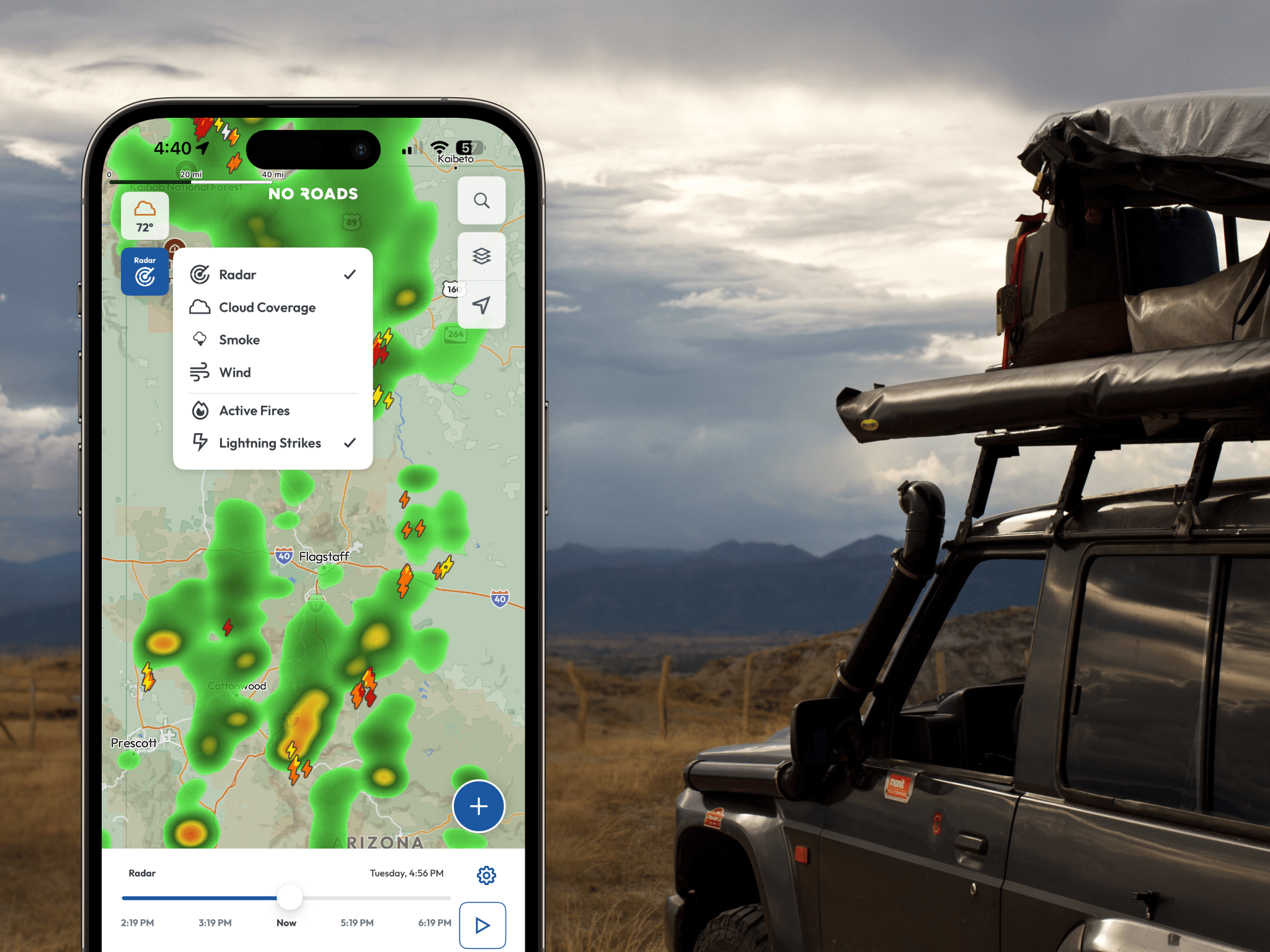You round a bend on an unfamiliar trail, expecting clear passage ahead. Instead, a massive tree blocks the route—fallen since the last time anyone documented this path. Without current information, you’re left guessing: attempt to navigate around it, turn back and find an alternative route, or push forward hoping the obstruction is passable?
Trail conditions change constantly. Weather events bring down trees and trigger rockslides. Heavy rains wash out roads and create unexpected water crossings. Seasonal closures appear without warning. What was clear passage last week might be completely impassable today.
Community-driven hazard reporting transforms how off-road adventurers stay informed about current trail conditions. Rather than discovering obstacles the hard way, you can benefit from the real-time knowledge of fellow explorers who’ve traveled these routes before you.
Why hazard reporting matters
Traditional trail information is often outdated by the time you access it. Official agency reports might be weeks or months behind actual conditions. Printed maps show static information that doesn’t reflect recent changes. Even recent trip reports on forums can be obsolete within days during active weather periods.
Real-time hazard reporting through platforms like No Roads creates a living map of current conditions. When an adventurer encounters a significant obstacle, they can immediately alert others through the No Roads app. This collective intelligence helps the entire community make better decisions, avoid unnecessary risks, and plan more successful adventures.
The benefits extend beyond individual safety. Accurate hazard information reduces the likelihood of adventurers getting stuck or requiring rescue assistance. It helps prevent vehicle damage from unexpected obstacles. It allows groups to plan alternative routes before committing to potentially impassable trails.
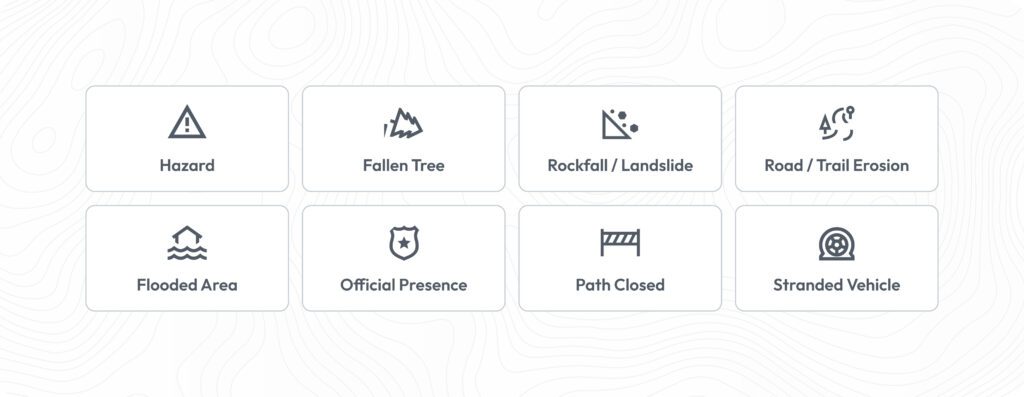
Understanding trail hazards
Not all trail obstacles are created equal. Some require simple navigation adjustments, while others demand turning back or seeking alternatives. Understanding different hazard types helps you assess risk and make informed decisions.
Natural Obstacles:
- Fallen trees: Can range from minor branches to complete trail blockages requiring chainsaw work or winching
- Rockfall/landslide: May indicate unstable slopes and ongoing danger beyond the immediate obstruction
- Road/trail erosion: Creates dangerous drop-offs, challenges vehicle clearance, or makes routes impassable
- Flooded areas: Depth and current can be deceptive; what looks crossable might hide dangers
Administrative Restrictions:
- Official presence: Law enforcement or rangers may indicate enforcement activity, checkpoints, or area closures
- Path closed: Official or temporary closures due to maintenance, seasonal restrictions, or hazardous conditions
Situation-Dependent Hazards:
- General hazard: Catches various conditions not covered by specific categories
- Stranded vehicle: May indicate trail difficulties ahead or create obstacles requiring navigation around
Each hazard type provides context about what you might encounter and how to prepare. A flooded area demands different decision-making than a fallen tree. Understanding these distinctions helps you respond appropriately.
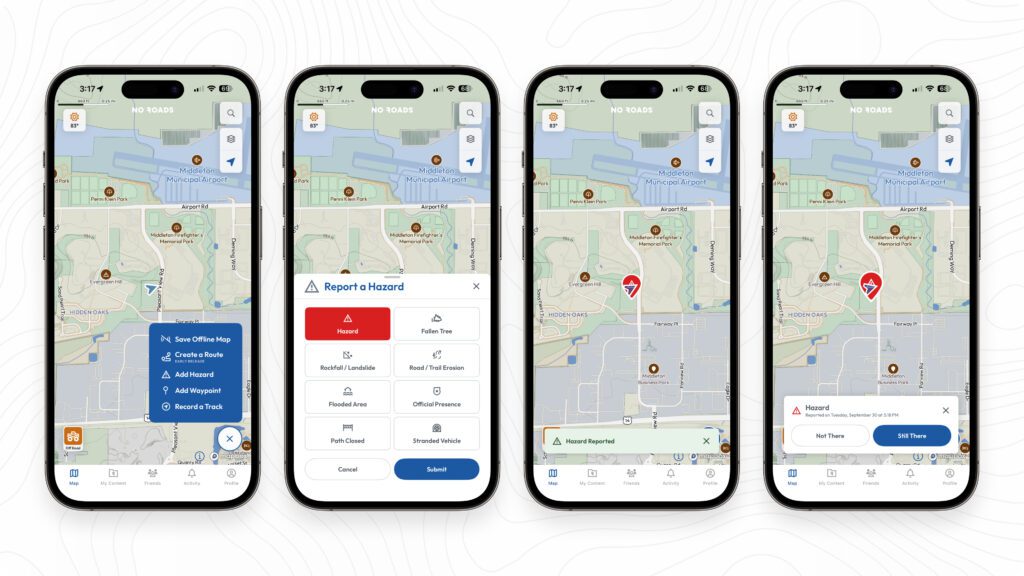
How to report hazards in No Roads
When you encounter a significant trail obstacle, reporting it takes just moments but benefits countless fellow adventurers. No Roads makes hazard reporting straightforward and immediate.
The reporting process:
- Encounter the hazard: Stop at the obstacle location when it’s safe to do so
- Open No Roads: Tap the blue plus button in the lower right corner
- Select “Add Hazard”: Choose this option from the menu
- Choose hazard type: Select the category that best describes what you’ve encountered
- Submit the report: Tap submit to share the information with the community
The system automatically tags the hazard with your current location, ensuring accurate placement for other adventurers. This location-based reporting ensures hazards appear exactly where they exist, giving approaching explorers precise information about what’s ahead.
Important reporting considerations:
Report hazards as you encounter them, not after the fact. The system requires you to be at the hazard location to ensure accuracy. This prevents misplaced reports that could mislead other adventurers.
You can report hazards during active track recording without interrupting your journey documentation. This allows you to maintain a complete record of your adventure while still contributing critical information to the community.
Choose the most accurate hazard category available. While “general hazard” works for unique situations, specific categories like “fallen tree” or “flooded area” provide more actionable information for other explorers planning their routes.
Responding to hazard alerts
No Roads actively alerts you when you’re approaching reported hazards, giving you time to assess your options before encountering obstacles. Understanding how to interpret and respond to these alerts maximizes their value.
Proximity alerts: As you approach a reported hazard, No Roads displays an alert on your screen. This advance warning lets you slow down, evaluate conditions, and prepare for potential obstacles before you’re on top of them.
Viewing hazard details: Tap on any hazard marker to see its type and location. Even if you’re not close enough to verify the hazard yourself, this information helps with route planning and decision-making.
Community verification: When you’re close to a reported hazard, you’ll see two verification options: “still there” or “not there.” This system keeps hazard information current by letting adventurers confirm or clear reports based on actual conditions.
Use these verification tools responsibly. Only mark a hazard as “not there” if you’ve actually confirmed its clearance. Similarly, confirming “still there” helps other explorers trust that reported obstacles remain active concerns.
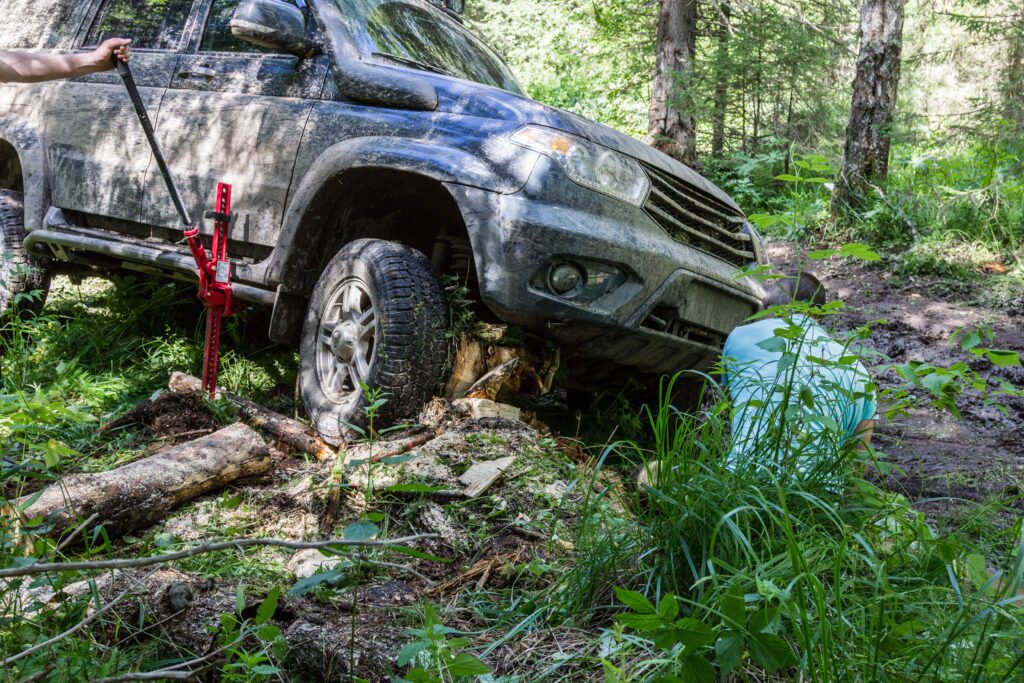
The importance of accurate reporting
Community-driven systems only work when participants contribute honest, accurate information. Every report affects dozens or hundreds of fellow adventurers making real-time decisions about their routes and safety.
Report what matters: Focus on significant obstacles that genuinely impact trail navigation or safety. Minor challenges that most vehicles can handle without difficulty don’t require hazard reports. Save reports for conditions that force decisions: turning back, finding alternative routes, or requiring special equipment or skills.
Choose accurate categories: Taking an extra moment to select the correct hazard type provides more valuable information than quick, generic reports. Other adventurers use these categories to assess whether they have the equipment and experience to handle reported obstacles.
Verify when possible: If you encounter a hazard that’s already been reported, take a moment to verify its status. Confirming “still there” reinforces the report’s accuracy. Marking “not there” when hazards have been cleared helps others plan more confidently.
Update when conditions change: Trail conditions evolve. That flooded crossing might drain within days. The fallen tree might get cleared by other adventurers or agency crews. Keeping reports current maintains system reliability and community trust.
Accurate reporting isn’t just good citizenship—it’s an investment in the collective safety and success of the adventure community. The information you provide today might prevent another explorer’s vehicle damage, rescue situation, or ruined trip tomorrow.
Building situational awareness
Hazard reports provide valuable information, but they’re one component of comprehensive trip planning and execution. Building strong situational awareness means combining multiple information sources and exercising good judgment.
Before your trip:
- Check recent hazard reports in No Roads along your planned route
- Research typical seasonal conditions for the area
- Understand current weather patterns and recent precipitation
- Review trail ratings and difficulty assessments from the No Roads community
- Identify alternative routes in case primary plans become untenable
During your adventure:
- Monitor hazard alerts as you progress
- Assess actual conditions against reported information
- Stay alert for unreported obstacles or changing conditions
- Consider whether conditions you’re encountering warrant new reports
- Communicate with your group about hazards and decision points
Balancing information and experience: Hazard reports inform decisions but shouldn’t replace personal assessment and judgment. A reported obstacle might be more or less challenging than described depending on your vehicle capabilities, driver experience, and current conditions. Use reports as valuable data points while maintaining responsibility for your own safety decisions.
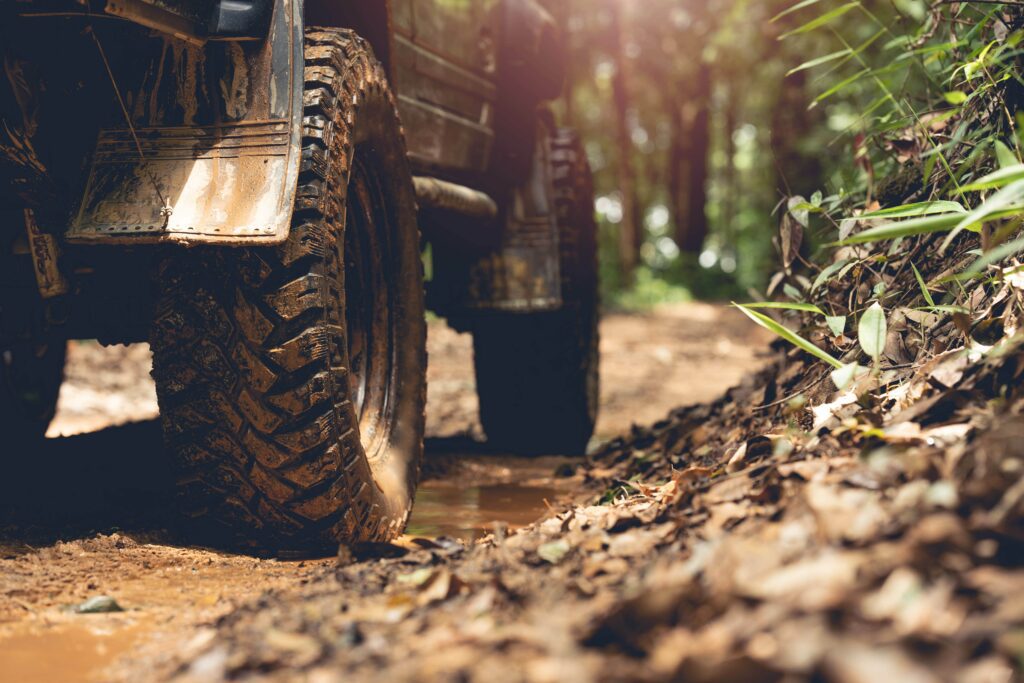
When to turn back
Not every reported hazard requires turning back, but knowing when to abandon a route demonstrates good judgment and prevents emergencies. Several factors should influence this decision.
Consider these warning signs:
- Multiple hazard reports along your planned route suggest deteriorating conditions
- Reported obstacles exceed your vehicle’s capabilities or your recovery equipment
- Weather conditions are worsening rather than improving
- You’re traveling alone without backup support
- Daylight is running short and navigation becomes more challenging
- Your group lacks the experience or equipment to handle reported obstacles safely
Turning back isn’t failure—it’s smart adventuring. Every experienced off-roader has stories of routes abandoned for good reasons. Living to explore another day beats pushing forward into situations that exceed your capabilities or resources.
Contributing to trail stewardship
Beyond reporting hazards, consider what role you can play in trail maintenance and improvement. While hazard reporting alerts others to problems, taking action to address obstacles benefits the entire community.
When it’s appropriate to clear obstacles:
- Removing small debris or branches that any adventurer could handle
- Filling minor erosion that doesn’t require heavy equipment
- Clearing drainage to prevent water damage to trails
- Reporting major issues to appropriate land management agencies
When to leave it to professionals:
- Large fallen trees requiring chainsaw work or heavy equipment
- Significant rockfall or landslide situations
- Major erosion or washouts affecting trail integrity
- Hazards on routes you’re not certain are legal to access
Always consider your own safety and legal authorization before attempting trail work. Some actions require permits or agency coordination. Focus on minor improvements within your capabilities while reporting major issues through proper channels.
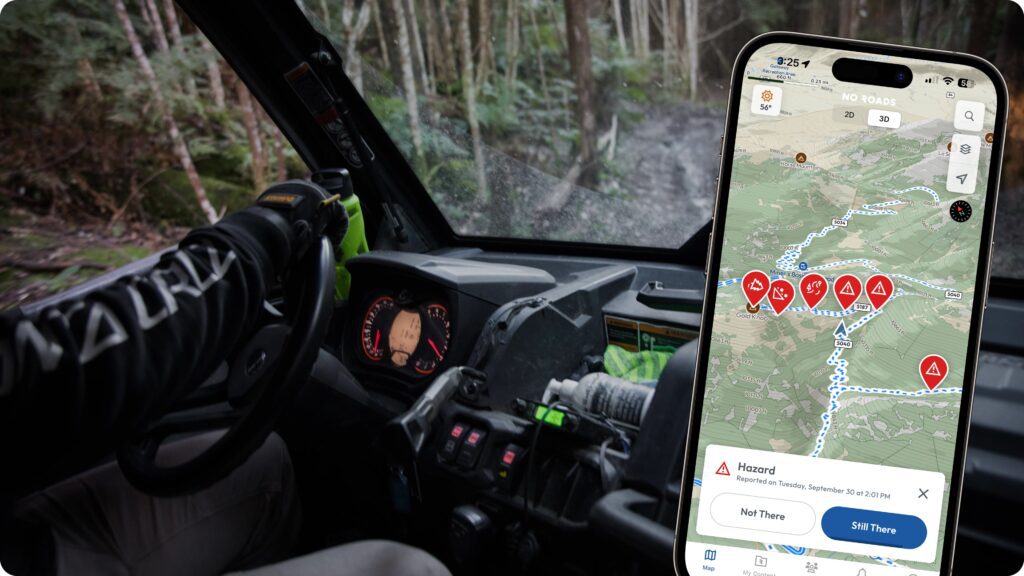
The future of community-driven safety
Real-time hazard reporting through apps like No Roads represents a significant evolution in how outdoor communities share critical information. As more adventurers adopt these tools and contribute actively through the No Roads platform, the collective knowledge base becomes increasingly valuable and reliable.
This shift toward community-driven intelligence doesn’t replace traditional resources like agency reports or local knowledge—it complements them. The combination of official information, No Roads community reports, and personal research creates the most complete picture of current conditions.
The effectiveness of these systems depends entirely on community participation. Every accurate report you file, every hazard you verify, and every obstacle you help clear contributes to safer, more successful adventures for countless fellow explorers.
Start contributing today
Hazard reporting works when everyone participates. On your next adventure, commit to being an active contributor rather than just a passive consumer of information. Report significant obstacles as you encounter them. Verify existing reports when you can. Help maintain system accuracy by updating conditions as they change.
The information you share today might prevent another adventurer’s emergency tomorrow. The hazard you verify could save someone hours of wasted travel time. The community you help build will be there to support you on your own future adventures.
Adventure safely, explore responsibly, and help your fellow explorers navigate confidently by sharing what you learn along the way.
Any terrain. Any adventure. No limits. No Roads.




